BikeAdvice Informative Series: We discuss the various types of disc brakes and what are their advantages and disadvantages in this part 1 of the ‘Braking’ series..
As we all know drum brakes are not sufficient in today’s conditions. They require more effort from the rider, need to be adjusted frequently and are less effective overall. To overcome these problems disc brakes are used. A disc brake uses hydraulic pressure to stop the vehicle. It is widely used in motorcycles, cars, trucks, buses, bicycles etc but in this story we will only focus on motorcycle disc brakes.
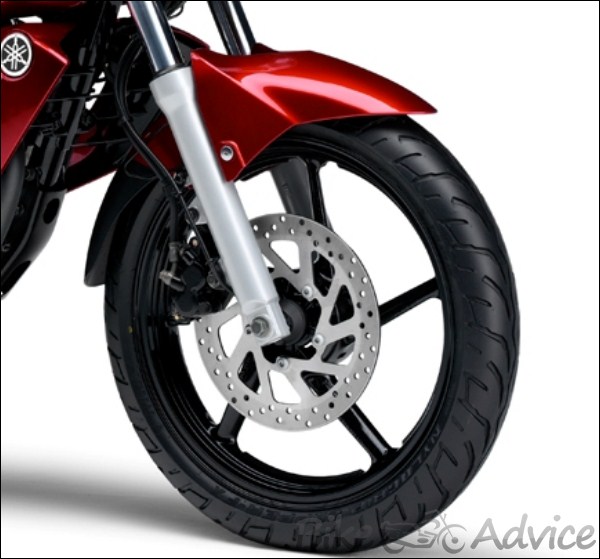
Brief History of Disc Brakes
The first caliper-type automobile disc brake was patented by Frederick William in 1902 but it failed due to the use of a copper disc. The first motorcycles to use disc brakes were racing machines.
The first mass-produced road-going motorcycle to sport a disc-brake was the 1969 Honda CB750 which was a very successful model for the company. Honda was planning to sell 1500 units a year but the demand surged to 3000 units a month.
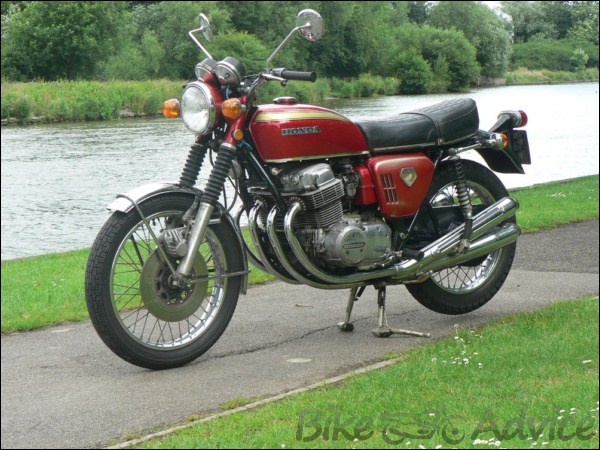
A Disc brake assembly contains brake rotor (Disc), Calipers, brake pad, master cylinder, brake lever or pedal and cable. We will talk about the disc in this article and other parts will be covered in part 2 of this series.
Brake Rotor or Brake Disk
The brake rotor or brake disk is the main rotating part of the disk brake assembly. It is the component by which the brake caliper clamps its hold to stop the wheel rotation. It is hard wearing and resists high temperatures that occur during braking.
It is generally made of cast iron. In high performance vehicles composite materials such as ceramics or carbon fiber are used to make rotors. Since some of the rotors have directional vanes they can be fitted to only one side of the vehicle.

Size of rotor/disc:
The size of disc/rotor plays an important role in the efficiency of disc brake. In India, we find mostly 240-300 mm front discs on motorcycles. One example of a large rotor was this Buell XB12SX Lightning City X which used 375 mm front disc brake.
The front disc is always larger than the rear disc because the front brake is more effective in stopping a two wheeler than the rear brake. In general, the larger the rotor/disc the better is the braking of the motorcycle. There are following reasons behind the same.
Why Larger Disc Provides Better Braking?
- A larger rotor provides more surface area compared to a smaller rotor. The brake pads maximum grip is generated while initial bite. After the initial bite the level of grip tends to fall. So if a brake pad provides larger area in the initial bite it will stop the vehicle early.
- When we apply brakes, a lot of heat is generated. This makes discs to overheat. In order to avoid overheating, the disc is needed to cool constantly. A smaller disc has low surface area to disperse the heat while larger disc has more surface area to disperse the heat, which in turn cools the disc earlier. Result is better braking power.
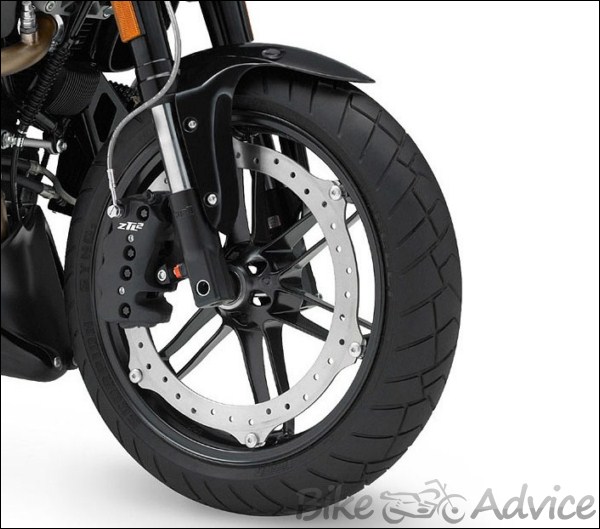
- The further the contact point of rotor and pad from the rotation of axle the more the braking torque is generated. In the large disc/rotor the contact point is at a higher distance as compared to a smaller rotor. The same principal applies to a door handle which is on the opposite side of the hinge. That’s why some bikes have rotor nearing the wheel rim. (See above picture)
- The larger disc/rotor is heavier than the smaller which also helps while stopping the vehicle.
Type of Disc Brakes

In motorcycle disk brake assembly, rotors can be cross slotted or cross drilled. Both of these are known as ‘ventilated’ discs. Previously plain disks were used as rotors.
Cross Drilled Rotor

In this kind of rotor you will find holes drilled in the disk. This style was first introduced in 1960 in racing cars.
The main advantages of this type of rotor are:
- The drilled holes help to disperse heat which is generated while braking. When brake pads come in contact with the disc lots of heat gets generated. The cross drills help to disperse this heat and gas.
- The same reason also helps in reducing brake fade under repetitive and hard braking.
- It is widely used. In India we mostly find this type of brakes.
- Some weight saving is also achieved due to cross drills.
- Plus, the aesthetics – the disk looks ‘better’ with holes.
There are few disadvantages as well
- Though rarely, but this kind of rotor could crack down due to two reasons – First, the surface of disk is weakened while drilling holes in the disk and due to large amount of heat and forces.
- Drilled rotors remove more surface area than slotted rotors (discussed later) which reduces instant braking.
Cross Slotted rotors
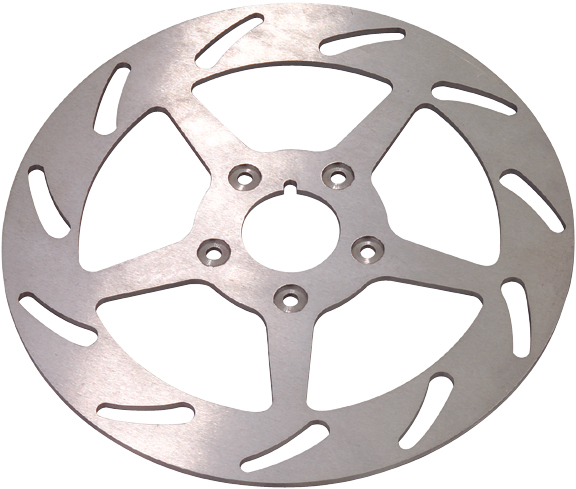
Long Stroke and Short Stroke Engines – Explained in Simple Terms
In cross slotted rotors, slots are shallow channels machined on the surface of the disc. The slots can be of various depths and widths and can be machined in different angles. They are not as popular as Cross Drilled rotors. We have seen them mostly on some Harley Davidson motorcycles.
Its advantages are as under:
- Cross Slotted rotors have almost double the life as compared to cross drilled rotors.
- Slots help to keep the brake pads clear of dust and other debris.
- These rotors are more efficient in rain conditions to splash water off the disk.
- They have higher surface area then Cross drilled rotors which help in effective braking.
- Cross Slotted rotors are considered more effective in dispersing heat compare to Cross drilled rotors
Motorcycle Suspension, Working & Maintenance – Explained
Disadvantages:
- The brake pads worn out faster in case of Cross Slotted rotors.
- They are not very popular in low capacity bikes.
Cross drilled and slotted rotors
To overcome the problems of Cross drilled and Slotted rotors a new type Cross Drilled and Cross Slotted type rotor is used. It has both the advantages of the Cross Drilled and Cross Slotted while minimizing the disadvantages.
Informative: How Drum Brake Works? Explained with Pics
Petal Rotor/Wave Disk

There is another type of rotor/disc which is known as petal disc or wave disk. The outer edge of the rotor is shaped like a wave instead of a plain circle. The petal disc is more effective while braking as compared to plain circular disc.
Centrifugal Clutch in Auto Transmission – What is it & How it Works
Advantages of Petal Discs:
- By now we already understand that a larger surface area provides better stopping power. The waves of petal discs are designed in such a way that they constantly provide new surface area for pad to bite on disc while rotation.
- Due to the same reason pads are always at the optimum braking point
- This designing structure of wave also helps to keep the rotor cool. It also avoids overheating of the rotor.
- The petal disc weighs lesser than big rotors. The motorcycle’s front wheel has less mass rotating with it which makes acceleration faster even though there is no horsepower gain.
- Lesser weight may also improve cornering of the motorcycle as there is less centrifugal force.
There is only one major disadvantage of this kind of disc that it wears out the pads at a faster rate.
How Petrol Pump Attendants Cheat You – Quick Pointers
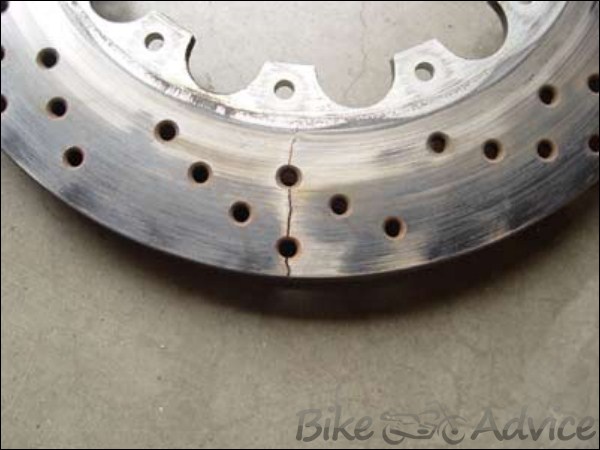
INFORMATIVE: How Motorcycle Tyres Are Manufactured?
Damages Caused to the Rotor
The rotor can be damaged in one of the three ways – warp, scar and crack.
- Warping is caused due to two major reasons – one is heat generated during friction between the pad and the rotor and another is an overheated disc cooled down immediately. Both of these conditions could cause deformation. Improper lug nut settings can also cause warping.
- Cracking which generally occurs only in drilled discs. Holes near the edge of the disc develop cracks because of the disc’s uneven rate of expansion when heated.
- Overheating of disc also causes scaring.
Tyre Ratings, Maintenance: All You Must Know About Tyres – in Simple Terms
Hope you like the information that is provided in this article. Do share it with your friends who may want to know about it…
Next Read: “Which Engine Oil Shall I Use?” – Engine Oil Explained in Very Simple Terms
– Mahavir Kothari

![Royal Enfield Guerrilla 450 Launch This Year [Speculation]](https://bikeadvice.in/wp-content/uploads/2022/12/Royal-Enfield-Hunter-450-pic-headlamp-100x70.jpg)
